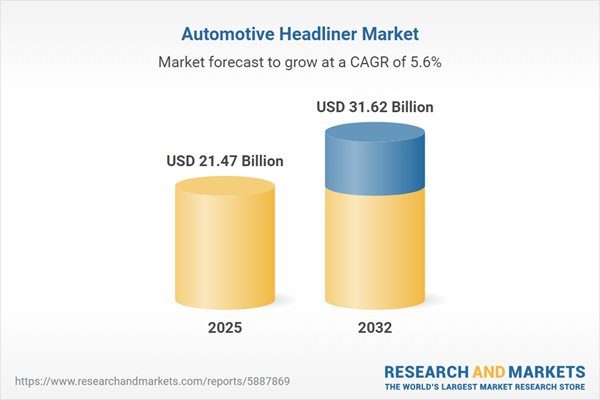Speak directly to the analyst to clarify any post sales queries you may have.
Automotive headliners have become a key lever for vehicle differentiation, serving as a core element in the evolving strategies of senior leaders aiming to stay ahead in the competitive automotive supply chain. To respond to shifting regulatory pressures, changing consumer expectations, and advances in materials, decision-makers require targeted insights into the complexities of the automotive headliner market.
Market Snapshot: Automotive Headliner Market Size and Growth
The automotive headliner market is experiencing robust growth, increasing from USD 20.39 billion in 2024 to USD 21.47 billion in 2025. A continued expansion at a CAGR of 5.63% is set to bring the market to USD 31.62 billion by 2032. Market momentum is driven by demand for high-quality vehicle interiors, sustainability, and innovation across both passenger and commercial vehicle sectors. Automotive OEMs are leveraging advanced headliner technologies to set themselves apart, enhance consumer satisfaction, and align with evolving efficiency standards worldwide.
Scope & Segmentation of the Automotive Headliner Market
This report offers executive leaders comprehensive coverage of the automotive headliner market, detailing core segments, innovation trends, and regional developments, all designed to inform strategic planning decisions across the supply chain.
- Material Types: Engineered composites such as carbon fiber and fiberglass-reinforced options; a range of fabrics including acrylic, nylon, polyester, and wool; high-function foam-backed substrates; and thermoplastics like polycarbonate and polyethylene, each influencing weight management and recyclability.
- Functional Applications: Solutions for enhancing in-cabin style, acoustic comfort, and thermal insulation, all of which contribute to an improved passenger experience and support energy efficiency objectives.
- Vehicle Categories: Coverage of both commercial vehicles—buses, trucks, pickups, vans—and all passenger cars, including hatchbacks, sedans, and SUVs. Each segment requires tailored headliner solutions to suit functional and regulatory needs.
- End User Channels: Focus on OEM-specific programs alongside aftermarket trends, highlighting the value of adaptable modular systems and seamless integration for diverse automotive platforms.
- Geographical Coverage: Insights span the Americas—including the US, Canada, Mexico, and major South American countries—as well as Europe, Middle East, Africa, and a broad scope of Asia-Pacific markets. This reflects varying compliance requirements and market dynamics that can affect entry strategies and growth priorities regionally.
- Featured Companies: Strategic profiles of key industry leaders, including Adler Pelzer Holding GmbH, Glen Raven Inc., Atlas Roofing Corporation, AUNDE Group, Daehan Solution, Freudenberg SE, Grupo Antolin Irausa S.A., Kasai Group, Lear Corporation, Motus Integrated Solutions, Sage Automotive Interiors Inc., Sika AG, and Toyota Boshoku Corporation, among others, illustrating advances in technology and market positioning.
Key Takeaways for Automotive Headliner Market Leaders
- Integrating acoustic management, thermal insulation, and innovative design, headliners now enhance in-cabin comfort while strengthening brand distinction.
- The shift toward lightweight composites and advanced foam materials aligns with ongoing efforts to reduce vehicle mass and meet regulatory demands for energy efficiency.
- Automakers prioritize recyclable thermoplastic materials to address environmental mandates and enable streamlined manufacturing.
- Modular solutions and improved product flexibility help OEMs and aftermarket providers maintain supply chain agility amid uncertain material costs and ongoing logistical disruptions.
- Enhanced digital manufacturing processes and configurable headliner systems are meeting the growing demand for premium, customized vehicle interiors across global markets.
- Shifting regional regulatory frameworks and changing consumer demands—especially across European markets—require continuous product adaptation and innovative production strategies.
Tariff Impact: Managing Regulatory and Cost Shifts
Recent tariff interventions in the United States, focused on thermoplastics and specialty foams, have increased complexity for suppliers. Leading organizations are diversifying suppliers, increasing local and regional sourcing, and adopting nearshoring strategies to manage regulatory risk and cost volatility. Building resilient supply chains and ensuring regulatory compliance are becoming central to sustaining growth and market flexibility.
Methodology & Data Sources
This market assessment is grounded in executive-level interviews with regional suppliers, authoritative industry research, and a thorough review of regulatory developments. The research benefits from rigorous benchmarking and data triangulation, supporting the practical needs of B2B stakeholders.
Why This Report Matters for Senior Decision-Makers
- Delivers strategic guidance on trends such as vehicle electrification and digital integration with headliner solutions, empowering teams to optimize procurement and design processes.
- Supports executive initiatives in driving material innovation, responding to region-specific compliance, and overcoming supply chain barriers for sustained growth.
- Equips stakeholders with tools for continuous benchmarking and evidence-based decision-making across the complex global automotive supply chain.
Conclusion
Navigating the automotive headliner market requires a flexible approach that balances regulatory, supply chain, and consumer demands. Equipped with actionable analysis, industry leaders are empowered to shape transformation, drive competitiveness, and mitigate operational risks in a dynamic sector.
Additional Product Information:
- Purchase of this report includes 1 year online access with quarterly updates.
- This report can be updated on request. Please contact our Customer Experience team using the Ask a Question widget on our website.
Table of Contents
3. Executive Summary
4. Market Overview
7. Cumulative Impact of Artificial Intelligence 2025
Samples

LOADING...
Companies Mentioned
The key companies profiled in this Automotive Headliner market report include:- Adler Pelzer Holding GmbH
- Glen Raven, Inc.
- Atlas Roofing Corporation
- AUNDE Group
- Daehan Solution
- Freudenberg SE
- Grupo Antolin Irausa, S.A.
- Howa USA Holdings, Inc.
- Kasai Group
- Kolon Industries, Inc.
- Lear Corporation
- Motus Integrated Solutions
- SA Automotive
- Sage Automotive Interiors, Inc.
- Shanghai Daimay Automotive Interior Co., Ltd.
- Shigeru Co., Ltd.
- Sika AG
- SMS Auto Fabrics
- Toray Industries, Inc.
- Toyota Boshoku Corporation
- UGN, Inc.
Table Information
| Report Attribute | Details |
|---|---|
| No. of Pages | 181 |
| Published | October 2025 |
| Forecast Period | 2025 - 2032 |
| Estimated Market Value ( USD | $ 21.47 Billion |
| Forecasted Market Value ( USD | $ 31.62 Billion |
| Compound Annual Growth Rate | 5.6% |
| Regions Covered | Global |
| No. of Companies Mentioned | 22 |









